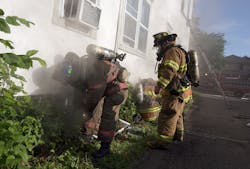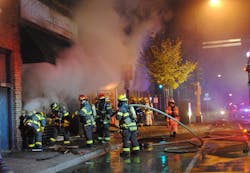Truck Tactics: Residential Basement Fire Operations
This month, I write with a heavy heart. I hadn’t finished this column when we suffered a tragedy in my department. Firefighter Jason Arno, who was a three-year veteran of the Buffalo Fire Department, lost his life on March 1, 2023, while he battled a four-alarm fire downtown. The past weeks have been very tough on our city and, most particularly, on the BFD. The support from the citizens and the fire service has been tremendous, almost overwhelming to our membership.
This subject of this Truck Tactics column is residential basement fires. Responding to one can be difficult and potentially dangerous. I don’t know many who are in the fire service who root for a hot, stuffy basement fire because of all of the challenges that it presents. These challenges often include restricted access to the fire—below grade and involving small, usually heavy-duty windows or glass block—and limited egress points. The small windows and limited egress also cause a ventilation problem, which is likely to produce limited or zero visibility.
Most basements that aren’t finished will be dark and cramped for space; sometimes, the ceilings are lower than what is the case on main floors.
Basements often become the collection point for decorations, old furniture and who knows what. This makes it difficult for firefighters to see and navigate the space, which can slow the attack.
- Sean Eagen will present “First Due Tactics for the Urban Truck Boss” at Firehouse Expo 2023.
Further, basements can have bedrooms and living quarters that aren’t up to code, which can mean challenging searches.
The weight of a house can put significant stress on the foundation and basement walls, which can make it more likely for the structure to collapse during a fire. Firefighters must be careful to avoid compromising the stability of the structure while they fight the fire. They also must pay close attention to utilities, gas appliances, and electrical and other hazards while they operate in this environment.
In addition, firefighters must be aware of the potential presence of hazardous materials, such as fuel, chemicals and asbestos. Of course, fuel and chemicals can increase the intensity of a fire, and the presence of asbestos can pose a health threat to firefighters who are exposed to it. All of these materials produce thick smoke and toxic gases, which makes it even more critical that firefighters wear their PPE, including SCBA, properly to protect themselves. When I say properly, that includes hoods on, facepieces on and waistbelts fastened. (An unfastened waistbelt is my biggest pet peeve.)
More dangers that firefighters face when they respond to basement fires include the potential for flashover or another traumatic fire event. The smoke and superheated gases generate so much heat that walls, ceilings and contents are ignited. Such a circumstance can lead to disorientation, serious injury or, in the worst case scenario, a line-of-duty death.
Size-up clues might deceive
Depending on construction type, smoke conditions might not point to a working basement fire initially. A good habit to get into when fire location isn’t obvious from the outside is to check each floor, basement first, and work one’s way up until the seat of the fire is located.
A typical bread-and-butter fire in my city is a 2½-story wood-frame house. Unless work was done over the years to modify the structure, most of these residences are balloon frame.
In balloon-frame construction, a fire that starts in the basement can become an attic fire quickly. Signs from the outside might point to an attic fire although the fire is burning hot in the basement. For this reason, most often, our lines are stretched through a side door, which provides access to all floors, including the basement and the attic.
Checking the basement doesn’t create much of a delay for firefighters when they use their tools to their advantage. A quick peek and assessment of conditions of the basement can save a lot of work and minimize damage for the homeowner. The simplest way to check the basement quickly is to scan with a thermal imaging camera (TIC). This isn’t a foolproof practice in a heavily cut up basement, but it usually shows enough to decide whether the basement requires further investigation.Basement layout
As a truck company officer, I always look for clues to what basement layouts are. The location of utilities, washers and dryers, and furnaces are priorities.
Basements often are consistent based on the neighborhood. That said, this doesn’t consider work that was done or the storage preferences of the individual homeowner, but at least it’s a starting point.
Truck crews also must be skilled in the use of any specialized equipment that might be needed for basement fires. Folding ladders or attic ladders come to mind when we think secondary egress—or primary egress in the event that the basement access point is burnt out or blocked.
A Bresnan distributor nozzle or old-school cellar pipes can be used to replace the tactic of putting members into a well-off basement if there’s certainty that there’s no life hazard in the basement.
Ventilation fans can be useful once firefighters are in position to handle the air. The fans add or remove air from the building, depending on the tactic.
Truck-specific tactics
Effective communication among members of the crew and all of those who operate at a basement fire is critical.
With a free-burning basement fire, you don’t want people operating above for any length of time until you have a handle on things in the basement.
Good communication and clear roles and responsibilities are a must for crews regardless of where the fire is. Lingo, jargon and common terms should be worked out among department members and the members of any other department that might come as mutual aid to the scene.
Truck companies should drill regularly on issues that they might face at a basement fire. Drills should include search techniques for areas of unknown layouts, with the potential for encountering clutter and small spaces. Good search techniques can be a life saver for members and the residents of the house.
Other truck-specific tactics at basement fires, in no specific order, are salvage work; access if stairs are gone or cut-off from fire; and primary and secondary egress points for other crews who operate below grade.
Safe and effective ventilation is key when operating to avoid flashover.
Another bit of advice that I always give to firefighters is to use TICs. Many free resources are available to help firefighters of all experience levels and ranks to learn to effectively use a TIC.
Specific to response to basement fires, a TIC allows firefighters to detect heat sources and potential fire hazards in a smoke-filled environment. The cameras can detect people who might be trapped in the basement, which allows firefighters to quickly effect a rescue.
Additionally, TICs can help to detect the presence of hazardous materials and to identify the location of fire extinguishment agents, which allows firefighters to better plan for suppression.
TICs also help to detect structural instability, which allows firefighters to exit the structure before collapse occurs.
All this said, firefighters can’t let the TIC take away from their training and experience by allowing them to get too deep or to lose orientation in the event that the TIC fails.
The respect that’s deserved
The Buffalo Fire Department lost two members to a basement fire in 2009. This event caused me to have a newfound respect for below-grade fires.
I dedicate this piece to Lt. Chip McCarthy and Firefighter Jonathan Croom, who lost their life on Aug. 24, 2009, and to Firefighter Jason Arno, who lost his life on March 1, 2023.
Rest in Peace, My Brothers.
Basement Fire Preparation
· Always wear the appropriate protective gear and ensure that your SCBA is in working order. Check SCBA every shift. Mask up and breathe a couple breaths to ensure that the seal is adequate.
· Use good size-up and anticipate potential flashover and the presence of hazardous materials.
· Make egress points a priority. These will be for an emergency or potential victim rescue.
· Work on crew and department communications. Focus on radio discipline and proper terminology that’s based on standard operating procedures.
· Take advantage of every opportunity for training and education on basement fires.
About the Author

Sean Eagen
Sean Eagen is a 26-year veteran of the Buffalo, NY, Fire Department. He currently is the captain of Truck 4. Eagen also is an instructor for the New York State Office of Fire Prevention and Control Special Operations Branch. He regularly presents at Firehouse's conferences.

